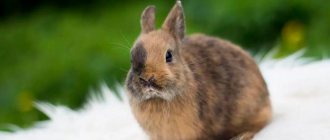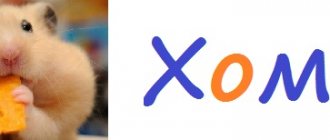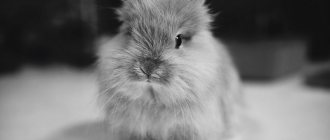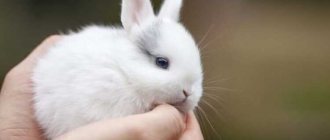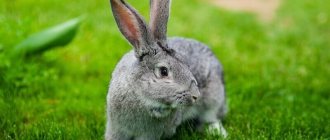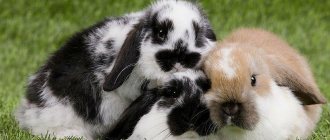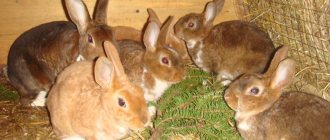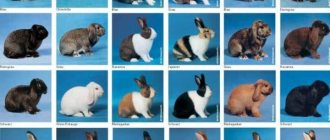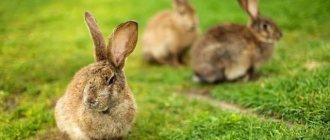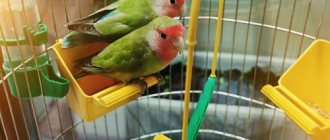Decorative, or as they are also called, small rabbits appeared relatively recently, but have already won special attention among the majority of the population around the globe. The reason for this popularity lies not only in the unusual appearance, but also in habits, nutrition and methods of care. Having decided to get yourself this beauty, you need to carefully weigh everything several times, because this pet, in addition to its beautiful appearance, can also bring with it a lot of trouble.
Now small rabbits are divided into two types: dwarf and decorative. Very often, inexperienced buyers fall for the tricks of dishonest sellers who can sell them a regular decorative rabbit instead of a dwarf one. Basically, the deception is revealed only when the decorative rabbit begins to grow up. To avoid this unpleasant moment, let's look at each type in more detail.
A decorative breed of rabbits is bred solely for the soul. In other words, any type of rabbit that has no practical use can be classified as decorative rabbits. In this case, the appearance of the rabbits, ranging from color, size and characteristics of the breed, can be absolutely anything. It is acceptable to call an ordinary rabbit decorative, which many breed specifically to produce offspring, skins or meat.
Standards are what not only allows one to clearly distinguish a decorative rabbit from a dwarf one, but also determine the breed that sellers offer. Every day more and more new breeds of dwarf rabbits appear, but we can consider only a few of the main and most popular of them.
Won't they grow up like meat ones?
I am often asked about the size of dwarf rabbits, some are afraid that they will be very large, like meat rabbits, and others want an adult palm-sized rabbit, so I decided to make a brief overview of the parameters of different breeds of rabbits.
As we can see in the photo above, even the largest dwarf rabbits will never approach the size of meat breeds. The maximum weight of a lop-eared rabbit is 2 kg, while meat rabbits weigh 5 kg or more, that is, their meat counterpart is at least 2-3 times more. So, we should not forget about the character of the animals, the selection of dwarfs is carried out not only by size, but also by the character of the animals, they must be kind to humans and not have bad habits. While meat rabbits are selected only for productive qualities and good manners, this is not a prerequisite for admission to breeding.
conclusions
Summing up the decorative breeds of rabbits, it is worth once again highlighting important points when choosing a breed:
- In total, there are more than 200 types of decorative rabbits, but when purchasing from the seller, there must be a pedigree for the animal indicating the breed and parents.
- Dwarf breeds weigh a maximum of 2 kg, and the length of the ears does not exceed 6 cm.
- Each variety of eared animals has its own character, and before purchasing a pet, you should carefully study this aspect in order to avoid unpleasant surprises.
- Long-haired species require regular brushing and removal of pellets. In addition to such care, it is also worth regularly vaccinating your rabbit - which and when to do is described here.
- Rabbits cannot tolerate loud sounds or bright lights. This can cause them to lose their appetite and get sick.
Also read about the dwarf breed - the fold-eared Ram.
We want a rabbit the size of your palm
It all depends on the size of your palm)) But seriously, there are no adult dwarf rabbits the size of a hamster; babies can be this size, for example minors. At 1.5 months they weigh about 300-400 grams, the size of half a palm.
Adult animals weigh about 1 kg and measure about 20-25 cm, which is just the size of the palm of an adult man or slightly longer than the length of a ballpoint pen. But we must take into account that such a small animal requires more careful care and maintenance, as it is easy for them to cause various injuries through negligence.
Content
A cage about 70 cm long is suitable for dwarf rabbits. It is better to buy a large house right away.
The dwarf rabbit needs a lot of space - it needs to run and jump
The cage is kept warm. It must have a plastic tray because the feet of mini rabbits are not adapted to the grid. Sawdust or hay are suitable as bedding. They are poured in a layer of 3-5 cm. Changed every 3-4 days.
Inside there should be a feeder, preferably heavy (you can hang it), as well as an automatic drinker, which is attached to the bars of the cage, and a manger for hay.
Optimal microclimate:
- temperature 18-20˚С;
- absence of dampness and drafts.
The cage should not be exposed to direct sunlight. High levels of hydrogen sulfide, ammonia and carbon dioxide in the air are harmful to ornamental animals. They do not tolerate stuffiness.
Dwarf rex
Rex rabbits can weigh up to 5.5 kg; dwarf breeds are lighter (up to 1.5 kg). Rex ears are not very long, up to 13 cm, erect.
The dwarf rex is truly unique. They have the shortest hair (1.5 cm) and the smallest whiskers among all decorative rabbits. They have a dense body, short legs, a narrow head, and medium-length ears (up to 7 cm).
Where is the best place to buy a decorative rabbit?
You can buy a baby rabbit:
- in the nursery;
- in a pet store;
- at the poultry market;
- through an Internet bulletin board.
Breeders advise using the first two options. By purchasing an animal from a specialized institution, you receive a guarantee that the baby is healthy, vaccinated and meets the breed standard.
As you can see, there are many varieties of decorative rabbits. The main advice is to choose your pet with your heart. Then he will become a friend and a full-fledged member of the family.
Dwarf hotot (Blanc de Hotot)
A very rare, and therefore more desirable breed for lovers of rare and beautiful animal breeds. This little animal was bred in Germany, although the French were the first to try to breed this breed.
The average weight of an adult individual barely reaches the 1.3 kilogram mark . A small but very compact body, very short ears, short and strong legs and an amazingly beautiful black eye rim are the characteristic features of this breed. Unlike other dwarf rabbit breeds, they are very playful, sociable, obedient and gentle.
Their fur is dense, shiny and fine. A true dwarf hotot has an exclusively white body color, but with breeding it can also produce another type of color. Today, the breed of colored dwarf hotots has already been officially recognized.
Walks and games
The well-known expression “Movement is life!” is suitable for rabbits. If the animal lives in a country house, then you can organize outdoor walks for it. If this is not possible, then it is necessary to let him out of the cage to wander around the room. We should not forget that these are rodents, for whom all wires and cords are attractive. During walks, the cage door should be kept open so that the pet can get in at any time.
For full development, decorative rabbits need to have fun and play different games. You can do this yourself or entrust it to your children, receiving double benefits. A small rubber ball is good for games. Various household items can also be used as toys.
Colored dwarf
This breed is also known to many as the short-haired dwarf rabbit. Typically, the body weight of an adult colored dwarf can range from 800 grams and barely reach one and a half kilograms . The animal's ears are always positioned upright, their length can vary from 5 to 5.5 cm. Despite their miniature size, practically absent neck and small body, the paws of rabbits of this breed are very strong. At the moment, more than 60 colors of the colored dwarf have been recorded. The fur coat of these pets has a very neat appearance and does not require special care.
It should be noted that during puberty, rabbits of these breeds can show aggression towards the owner, even sometimes biting or hitting with their paws. Typically, maturation occurs at one and a half years. Many sellers recommend spaying or neutering these animals to reduce aggression.
To summarize, we can conclude that the colored dwarf is quite funny and perfectly plays the role of a charming, active and funny pet.
Lion head
Little rabbits. Dwarf domestic rabbit breeds. Lion head
Judging by the name, rabbits of this breed are the smallest rabbits of all the above. The weight of an adult individual barely reaches 1.6 kilograms.
The weight of an adult individual barely reaches 1.6 kilograms.
The unique structure of the ears and the fur framing the muzzle and ears give this animal the appearance of a lion. Thanks to the short hair on the body, the head looks even larger than it actually is. Sometimes, but really very rarely, it becomes possible to find a species of dwarf lion's head, which, along with long hair on the face, is also decorated with long hair on the sides. Compared to their counterparts, the care and maintenance of these small rabbits is quite simple. Short hair does not require constant brushing, as it does not tangle or mat. Another, no less interesting feature of lion head rabbits is the beautiful edging around the eyes.
Rabbits of this breed are distinguished by their miniature but strong bodies. Their eyes always match the color of their fur coat, which can be completely different. The appearance of rabbits of this breed is quite charming; erect ears, a large head, strong and small paws will not leave anyone indifferent. It is impossible not to note the pliable and soft nature of pets, which can easily replace a real friend for a child. My only recommendation is that these rabbits simply hate being picked up by their ears.
Angora dwarf rabbit
The first type of Angora rabbit has 20 centimeters of thin Angora fur. Due to its decorative appearance, it is not immediately possible to determine what kind of animal it is.
The second type of Angora rabbit is smooth-haired; these rabbits have a fur length that barely reaches 5 centimeters; naturally, their fur coat requires less care.
In both species of dwarf angora, the weight of an adult individual ranges from 1 to 1.6 kilograms. Their long hair completely hides their miniature body. The coloring of rabbits of this breed is predominantly white; gray individuals are rare, but active work is now being carried out to breed blue, red, gray and black Angoras. It is very rare to have blue eyes in rabbits of this breed. One cannot fail to note the tufts of fur, which give this animal a very funny look.
Hermelin
Little rabbits. Dwarf domestic rabbit breeds. Hermelin.
This small white rabbit is also called the Polish rabbit or stoat. This breed has a very interesting history; previously it was bred specifically to produce skins reminiscent of ermine. The main feature of the Hermelin breed is the exclusively white color of not only the coat, but also the claws and skin. The eye colors of rabbits of this breed are blue and red. Small rabbit ears flaunt on a relatively large head. In general, the rabbit resembles a small toy, but it looks very impressive.
Due to their rather thick fur, they practically cannot tolerate heat. The character traits of both females and males are quite unique. Males are very lazy, they do not like being disturbed unnecessarily. Females, on the contrary, are active, but a little aggressive. But, all these features are quite individual. In general, breeding or keeping rabbits of this breed is recommended only to experienced rabbit breeders.
Dwarf ram
The dwarf ram is the smallest lop-eared rabbit. This baby is 28 cm tall and weighs about a kilogram.
The main decoration of the dwarf ram is long (up to 20 cm), fleshy ears, pressed tightly to the head and forming a kind of crown. Like all lop ears, they stick up at birth and fall off by three months. Their fur is soft and delicate. About 22 colors were developed.
Content
Once you have at least approximately decided on the choice of a furry pet, you need to start thinking about keeping decorative rabbits.
Where to start? To begin with, from the premises. They live in an ordinary room at a standard temperature
It is important that it is not wet or with a lot of drafts - this is unacceptable for decorative rabbits
The room needs to be cleaned regularly, just like the cage. A dusty and dirty home can cause many diseases. It’s a similar story with sunlight - it should be there, just not direct rays, especially not constant ones.
If you want your rabbit to live freely in an apartment, albeit with its own cozy corner, pay attention to everything that it can chew, because you can be sure that it will try. Rabbits chew on anything they can put in their mouths, and the wires are the first to suffer.
It is best to keep him in a cage, and when releasing him, carefully monitor him so that he does not do anything. Do not forget that if he tries to chew the wires, it can harm not only the equipment, but also the animal - the wire may be live.
English Angora
English Angora
Just like the Angora rabbit family, these tiny buddies are covered in fur from head to toe. Fully covered in fur, they look like a big ball of fur and require a special diet to stay healthy and happy. Unfortunately, they are mistreated for their fur and many actually die in the process.
Downy breeds
Rabbit down consists mainly of delicate wool fibers and is valued higher than sheep. It is widely used for the manufacture of knitwear and is obtained from shaggy animals, the length of which reaches 12-20 cm.
The most promising varieties in this direction include white downy, angora downy and arctic downy rabbits.
White downy breed
This relatively young breed was bred in the last century on the basis of classic Angoras. Its representatives are medium in size and weigh about 4 kg with a length of up to 54 cm. White downy rabbits have neat ears and short limbs.
Compact animals are covered with long 15-centimeter hair, which is characterized by great elasticity and is not prone to the formation of tangles.
Angora down breed
This ancient Turkish rabbit breed is a long-haired variety. The average weight of the Angora is 3 kg, and the length of its fur reaches 25 cm.
Each ear of a representative of this breed is crowned with a shaggy tassel, and the compact cylindrical body of the animal is covered with luxurious hair.
Arctic fox rabbit
This breed has long been bred in Russia. It is characterized by its small size and elastic, moderately dense gray or dark gray fur.
The average weight of animals reaches 3-3.5 kg, and the weight of fluff that can be collected from 1 individual is 350-400 g.
Nutrition
So, you brought a new pet home and the question arises: what to feed your dwarf rabbit?
Make sure your rabbit always has access to a drinking bowl with water. The diet must include succulent foods: cucumber, carrots, beets.
Fur varieties
The meat-hide breeds include some of the breeds already described above, but there are also species that focus on producing high-quality skins in addition to meat.
Voile silver
On the territory of Tatarstan, as a result of crossing the Soviet chinchilla, white giant, Flanders and Viennese blue breeds, a veil-silver breed was bred. She is gray in color with a subtle dark veil pattern. The silver tone appears after the first molt, and the veil pattern after the second. The fluff has a rich blue color. Standard weight is 4.5-4.8 kilograms.
Butterfly
This English beauty with an attractive skin, rather small, was bred in the lands of Foggy Albion as an ornamental animal. Russian breeders crossed her with several larger breeds: the Flandre and the Viennese Blue, a white giant. The result was large rabbits, weighing up to five kilograms, raised not only for meat, but also for their excellent skin. The dominant color of the skin is white, and black-brown spots on the neck, ears, nose and center of the back are a distinctive feature of the breed. There are up to eight rabbits in a litter.
Rex
An ancient German elite breed of rabbits. This is a fluffy dog with velvety fur, short and dense, similar to plush or sheared high-quality sheepskin. The color scheme is represented by chestnut or brown tones, diluted with lighter spots. It is the product of a natural mutation of the Flanders genus. It is highly valued for its beautiful skin. Underdeveloped whiskers, which are much shorter than those of other rabbits, are a characteristic of this breed. They weigh from three to five kilograms.
Vienna blue
It is a hybrid of Flanders and Moravian Blue and is an endangered species. The pride of the breed is the skin of a gray-blue or steel uniform color, which is acquired after the second molt. The hairline is very thick - 20,000 hairs per 1 cm². Successfully imitates the more valuable fur of fur-bearing animals. Live weight indicators are about 5 kilograms. Litter – 8-9 babies per litter. By the age of four months, newborns gain up to three and a half kg.
Ermine
This breed with roots of simple gray wild rabbits appeared on the Russian market at the beginning of the last century. It is called so for the similarity of the color of the skin with the color of an ermine. Rabbits that are white from birth acquire dark pigmentation after a month, and by six months the unusual color is fully formed, famous for the darkening of the tip of the nose, ears, paws and tail.
Rabbits are small, weighing up to four kilograms. They are resistant to diseases, omnivorous within the limits of their diet, and quickly adapt to any conditions. Female rabbits are prolific, with a litter containing about eight babies.
Soviet Marder
This breed was developed in Armenia thanks to two-stage selection. At the first stage, a Russian ermine and a Soviet chinchilla were crossed. The second shows the obtained specimens with local ones, blue in color. The result was short-haired animals with a valuable velvet skin, reminiscent of a marten. They are highly valued for the beauty of their skins, but mixed colors reduce the quality of the skins. An interesting transition is formed from the main light brownish color to a darker shade in the area of the muzzle and paws.
